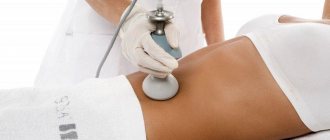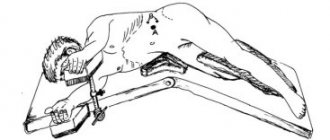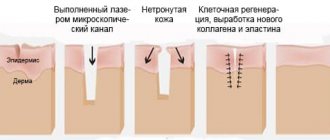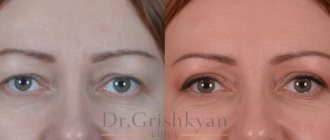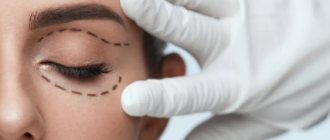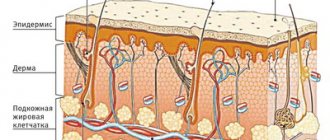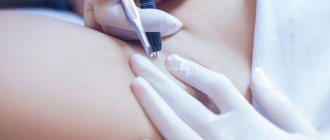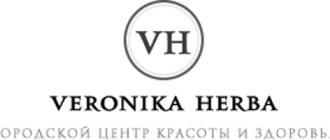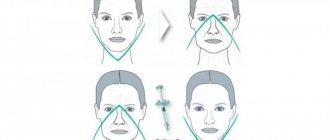Iontophoresis is a hardware procedure that is actively used in cosmetology to solve various aesthetic problems. The essence of the method is to conduct a low-voltage galvanic current that affects the upper and middle layers of the skin. A current pulse is supplied through electrodes, thanks to which the active components of the products can reach deeper layers of the skin. Due to this effect, the production of collagen and elastin is enhanced, metabolism is accelerated, and oxygen supply to cells is improved. Biological components during iontophoresis can be various cocktails, serums, essences, fluids and any other cosmetic compositions with a beneficial composition.
The choice of cocktails and serums is determined by the polarity of the electrode (plus or minus). With a positive charge, the following compositions can be used:
- Plant extracts;
- Vitamins B and E;
- Hyaluronodase;
- Healing mud and clay;
- Caffeine;
- Copper and zinc sulfate;
- Saline solutions.
For negatively charged electrodes, the following means are allowed:
- Vitamin C;
- Salicylic acid;
- A nicotinic acid;
- Hyaluronic acid;
- Hydrocortisone;
- Caffeine.
Since cocktails and serums are introduced into the body using galvanic current, side effects are kept to a minimum. This is justified by the fact that the substances enter the body in their pure form; they do not affect the internal organs. Also, thanks to iontophoresis in cosmetology, it has become possible to provide cocktails with a prolonged effect, thanks to the creation of a storage facility in the skin where beneficial substances accumulate and are consumed.
Which areas of the body can be affected, will it help with generalized sweating?
Iontophoresis is used to treat hyperhidrosis of the palms, soles and armpits. It is in these areas that a large number of eccrine sweat glands are located, which are responsible for thermoregulation.
Generalized hyperhidrosis occurs against the background of somatic diseases. These include neurological disorders, diseases associated with dysfunction of endocrine organs, respiratory and vascular insufficiency, malignant tumors and others.
In such cases, correct therapeutic tactics are required. Therefore, iontophoresis is not used for generalized excessive sweating.
Treatment of armpit sweating with iontophoresis
Hyperhidrosis in the axillary area can also be treated with iontophoresis, but access to this area is not as convenient as, say, the palms or soles. Despite this, special electrodes have long been invented that are applied directly to the armpit area. It is not very convenient to hold the electrodes with your hands during the session, but those who adapt and tolerate these inconveniences are very satisfied with the treatment. Most often, these are patients who are already undergoing treatment for hyperhidrosis of the palms and feet and have become convinced of its effectiveness. But still, for hyperhidrosis of the axillary region, iontophoresis is not the main method; botulinum toxin injections or antiperspirants are used much more often.
Contraindications
ATTENTION! Before carrying out the procedure, consult your doctor!
Iontophoresis is contraindicated in:
- cardiovascular diseases,
- blood diseases (anemia, leukemia, hemophilia),
- benign and malignant neoplasms,
- hypertrichosis (increased hair growth throughout the skin of the body),
- the presence of metal implants in the body and pacemakers,
- damage to the skin (cuts, injuries),
- epilepsy,
- pregnancy,
- exacerbation of skin diseases,
- acute infectious diseases.
METHODOLOGY FOR RECOGNIZING HYPERPERSPIRATION
Recognition of hyperhidrosis comes down to an objective examination. The neurologist performs the manipulations first; he is interested in:
- circumstances of the appearance of signs of hyperhidrosis;
- family history (the probability of inheriting hyperhidrosis in families is 35-65%);
- manifestations of other diseases - neoplasia, metabolic disorders, treatment of OD diseases, neurology, infection;
- recent treatment (nature and dosage of medications);
- localization of hyperhidrosis.
If underlying or underlying underlying pathologies are suspected, an instrumental and laboratory research program may be required. This includes ultrasound, MRI, skin testing, CBC/OAM, etc.
Carrying out the procedure
Preparation
Before the procedure, you need to determine the area and intensity of sweating. To do this, use the Minor test - iodine-starch test.
To do this, apply Lugol's solution to areas with increased sweating. Then the result is evaluated.
You should also remove all metal jewelry.
Progress of the procedure
To carry out iontophoresis, water is drawn into a special bath. Then the upper or lower limbs are immersed in the container.
The procedure in the armpit area is carried out using a special pad device. If the effectiveness is low, soda or anticholinergic drugs are added to the water.
The course ranges from 5 to 20 procedures lasting from 20 to 40 minutes. They can be repeated every day or every other day. The strength and type of current (constant or pulsating) is selected individually.
Recovery period
After completing the course of iontophoresis, the patient is transferred to the maintenance regimen. Depending on the achieved result, the procedure is repeated from once a week to once a month.
What is iontophoresis?
Iontophoresis is a hardware procedure that works using low voltage current.
Before the session begins, the skin is disinfected, then a cosmetic or medicinal product is applied.
The applied product is a medium that is affected by a microcurrent applied to the skin using the joystick of the device.
Iontophoresis increases blood circulation, and, consequently, oxygen saturation of skin cells and the penetrating ability of drugs.
In what cases is iontophoresis used:
- with increased acne, for example, in adolescents;
- in order to even out skin tone, get rid of redness (pigmentation);
- for stretch marks, unsightly vascular networks, varicose veins;
- to tighten the oval face - galvanic current stimulates muscles and removes fine wrinkles;
- in the treatment of hyperhidrosis (increased sweating).
Like phonophoresis, iontophoresis can be performed independently at home. But there are several contraindications:
- pregnancy and lactation - you must consult your doctor about this method of treatment. When carrying a fetus, it is recommended to refrain from the iontophoresis procedure in the abdominal area;
- the presence of a pacemaker, metal implants, gold threads for a facelift, etc.;
- infections and chronic heart diseases;
- fungus on the skin;
- intolerance to electric current.
During the iontophoresis procedure, you will experience a slight, pleasant tingling sensation that does not cause discomfort.
Unlike phonophoresis, not any cosmetics are suitable for this procedure. Since iontophoresis works with galvanic current, you need a product with the correct charge: negative “-” or positive “+”. As a rule, “charged” drugs are marked accordingly. You can set the desired polarity on the device itself.
What is suitable as a medicine during the iontophoresis procedure, and for what:
- B vitamins smooth out wrinkles and even out skin tone;
- Vitamin C reduces inflammation, itching, redness and repairs damaged tissue.
- nicotinic acid dilates blood vessels, so that the skin is better saturated with vitamins and toxins are removed.
- clay removes excess moisture, nourishes pores and enriches the epidermis with minerals;
- hyaluronic acid rejuvenates the skin;
- zinc makes the skin more elastic.
All substances are introduced with a positive electrode (except zinc). If you do get confused, nothing terrible will happen, the effect will simply not be as good as promised in the description of the chosen cosmetics.
How to choose a device
When choosing a device, you need to pay attention to the following details:
- availability of certificate and instructions,
- functional,
- ease of use,
- power,
- manufacturer.
Before purchasing, check the completeness of the device. In addition to the device itself, there should be two electrodes with flexible connecting cables, two polymer pads for electrode baths, two small treatment baths, electrodes for axillary therapy with fabric internal pockets and one external charger.
What it is
A low voltage can transform the structure of cell membranes, triggering the process of metabolism and regeneration. This occurs due to the formation of magnetic fields when electrodes with different poles are applied to the surface of the face.
At the Provence cosmetology clinic, the procedure is carried out using a modern microcurrent device. Please note that galvanic current is completely safe for the skin. Cosmetologists around the world have rightfully recognized this physiotherapeutic method as the most effective. With its help it is possible to solve a whole range of problems. After the first procedure, the skin looks noticeably better.
The price in cosmetology for one session ranges from 2700-3000 rubles. One course consists of 4-6 procedures, each of which takes 20 minutes.
Precautionary measures
Before carrying out the procedure, read the instructions. To avoid pain and complications, follow the recommendations:
- Before the procedure, remove all jewelry.
- If there are damages, lubricate them with protective cream or Vaseline.
- After the procedure, skin irritation may occur; use 1% hydrocortisone cream to eliminate it.
- Apply moisturizing creams to your skin to prevent and eliminate dryness.
- The total procedure time should not exceed that recommended by the doctor.
- If unpleasant sensations arise during the procedure, you need to reduce the current intensity to a comfortable state so as not to get burned.
So, iontophoresis for hyperhidrosis of the palms and soles is quite effective. Its use does not require special training; the procedure can be carried out at home. For axillary excessive sweating, iontophoresis can be combined with other methods aimed at combating increased secretion of sweat glands.
Iontophoresis for hyperhidrosis - history of the method
When performing iontophoresis, the patient immerses his hands and feet in baths of water.
Iontophoresis (also called galvanization) as a treatment method has a very interesting history. At the beginning of the twentieth century, when scientists just began to use electric current to treat various diseases, they tried to treat mainly muscles and joints. This direction developed especially rapidly in Germany.
Electrodes were lowered into a bath of water in which the drugs were dissolved, a weak current ran through them, and in this simple way the active substance was delivered to the diseased organ (for example, to a joint).
However, as pharmacology developed, more and more drugs appeared that did not require delivery using electric current. And the need for iontophoresis has noticeably decreased. But, most interestingly, a group of scientists noticed such a phenomenon - when treating any disease with electric current, an unusual effect appeared - sweating on the palms and soles decreased significantly. That is, the current somehow affected the sweat glands.
The equipment in those days was expensive and complex, so the method was not widespread. But during the twentieth century, doctors did not give up attempts to learn how to treat hyperhidrosis using iontophoresis. Experiments were carried out, medicines or various salts were added to baths of water, and galvanization devices were improved.
Theories of the effect of iontophoresis on sweat glands
And an unusual thing turned out - simple tap water under the influence of current had exactly the same effect on the palms and feet as medicinal solutions. And this did not depend on the cause of hyperhidrosis. The essence of the method today is explained as follows: the sweat glands of the human body react to sodium, potassium and, mainly, chlorine ions. After this discovery, iontophoresis for hyperhidrosis began to be used in Germany, the USA and Japan, and by the end of the 60s it had firmly gained its place among other treatment methods. The mechanism of action on the sweat glands has not yet been precisely elucidated.
There are two theories that try to explain the therapeutic effect: the first states that iontophoresis reduces the secretion of sweat directly from the sweat cells. According to another theory, iontophoresis causes blockage of the tubules through which sweat exits to the surface of the skin. Be that as it may, iontophoresis affects the palms and soles, and this leads to a decrease in hyperhidrosis. The main condition is that the patient must strictly follow the instructions received from the attending physician and, of course, the instructions for the device (if treatment occurs at home). In particular, if there are wounds or cuts on the palms or soles, they must first be lubricated with Vaseline so that electricity does not affect them.
